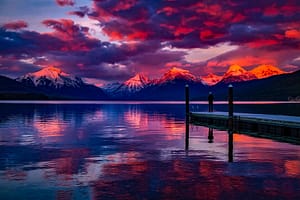Glacier National Park borders Waterton Lakes National Park in Canada — the two parks are known as the Waterton-Glacier International Peace Park, and were designated as the world’s first International Peace Park in 1932. Both parks were designated by the United Nations as Biosphere Reserves in 1976, and in 1995 as World Heritage sites.
Landscape
Glacier National Park is a stunning display of the geological processes that changed North America over the last billion years. The rock formations in the park are almost entirely sedimentary, laid down between 1600 to 800 million years ago when this area was an inland sea. They were uplifted during the formation of the Rockies beginning around 170 million years ago, and today contain some of the best Proterozoic fossils in the world. The mountains were carved into their present form by the advance and retreat of glaciers during the last ice age, and the park, as its name suggests, contains an abundance of glacial features, including lakes, valleys, and remnant glaciers (although these have diminished significantly in the last century).
Flora and fauna
The park offers many opportunities to see wildlife, and its ecosystems are almost unchanged from what they were at the time of Lewis and Clark. Different trails offer visitors close encounters with animals from mountain goats to pine martens. The park is also one of the largest remaining natural grizzly habitats, and during late summer, grizzlies will often come to lower elevations to eat the area’s popular berries and catch fish in the lakes. In addition to grizzly bears, the park is also home to two other endangered species: the Canadian lynx and the bull trout. 23 species of fish live in park waters, and fishing is a popular park activity. Birdwatchers will find many species of waterfowl in addition to larger birds of prey, including bald eagles.
Coniferous forest is the predominant ecosystem, although the forest is visibly different on the east and west sides of the Divide. Trails wind through subalpine meadows full of wildflowers and alpine tundras.

